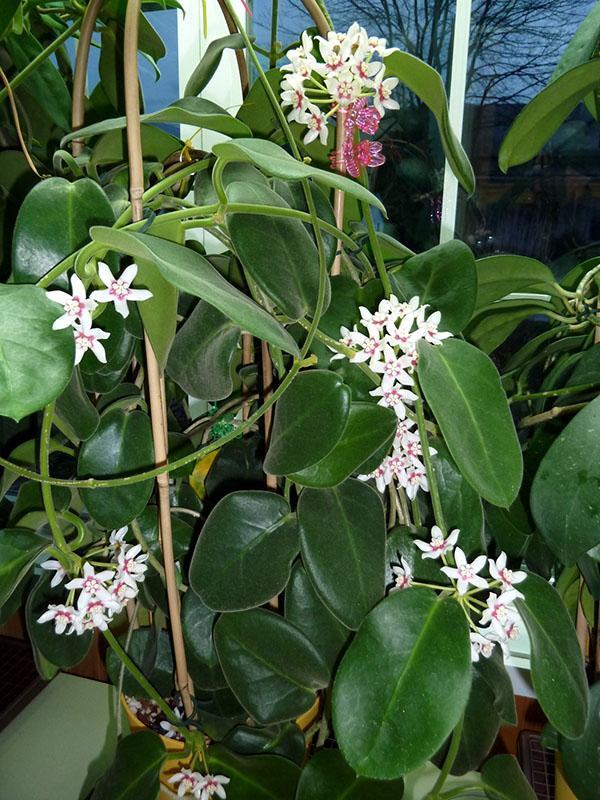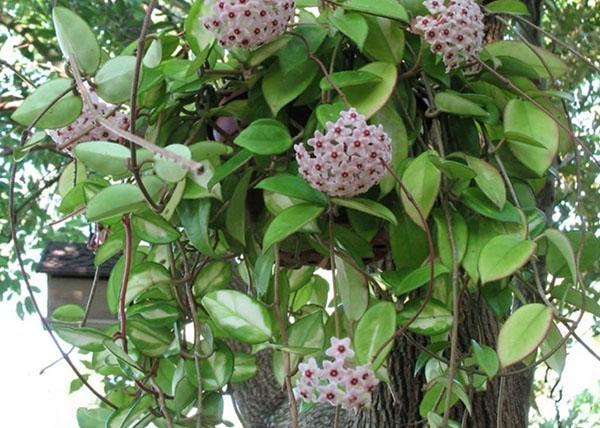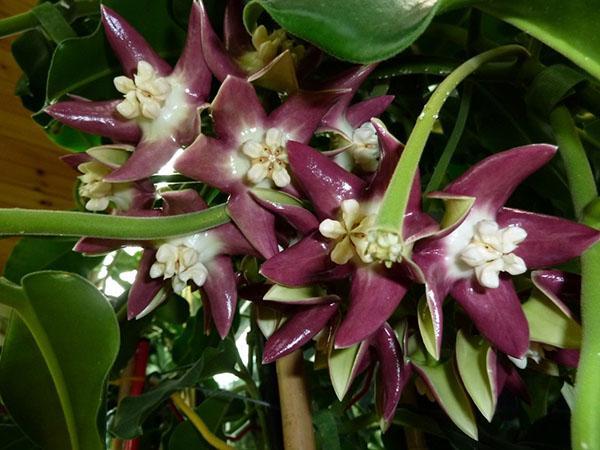Home care for hoya - unfamiliar nuances
 The glossy sparkle of foliage and the velvety charm of star-shaped corollas gathered in dense umbrellas of inflorescences attract lovers of indoor vines. Caring for a hoya at home will appeal to both a disciplined florist and a person who is forgetful or often traveling on business. Interior designers love to use a plant for vertical gardening - shiny hoya leaves give the green wall a special shimmering effect.
The glossy sparkle of foliage and the velvety charm of star-shaped corollas gathered in dense umbrellas of inflorescences attract lovers of indoor vines. Caring for a hoya at home will appeal to both a disciplined florist and a person who is forgetful or often traveling on business. Interior designers love to use a plant for vertical gardening - shiny hoya leaves give the green wall a special shimmering effect.
The genus Hoya of the Kutrov family includes 51 plant species, but about 450 names are in the status of uncertainty. Hoyi grow naturally in India, China, on the islands of the Malay Archipelago, in South Korea and off the northeastern edge of the Australian continent. The plant got its name in honor of the English gardener T. Hoy, who devoted his whole life to growing tropical plants in the greenhouses of the Duke of Northumberland.
Botanical portrait
Hoyi are perennial plants with climbing, climbing, sometimes drooping stems. Their leaves are fleshy, leathery, rich emerald color, with a characteristic sheen, up to 20 cm long, 5 cm wide, arranged oppositely along the pagon.
Flowers have a complex structure, are snow-white, cream, lemon-yellow, pink or salmon-scarlet, collected in axillary inflorescences. Corollas are five-lobed, the petals are fleshy, smooth, as if velvet to the touch.
In room culture, the most popular types are:
- Hoya fleshy, or wax ivy (H. carnosa) - liana with snow-white or pale beige fragrant flowers.

- H. majestic (H. imperialis) is a climbing plant with dark purple fragrant flowers.

- Hoya southern (H. australis) - creeping pagons are covered with white flowers with a red center.

- H. beautiful (H. bella) - a shrub with drooping stems and pink flowers with a pleasant smell, popular for ampel cultivation.

Reproduction of hoya at home
Florists practice sowing seeds and rooting stem cuttings. With a certain amount of patience, it is possible to grow hoya from a single leaf blade. Before propagating hoya at home, you need to familiarize yourself with the existing methods of obtaining new plants.
The best time for hoya breeding is the beginning of the growing season. Although the plant does not have a pronounced rest time, during the cold season of the year, the growth of the vine slows down. With the arrival of spring, hoya lends itself more effectively to reproduction, although it is possible to experiment with rooting of shoots in other months, but not at the time of flowering.
Hoya: propagation by cuttings
 The stalk is cut from a healthy pagon. It should be short - 5-6 cm, consist of two internodes and 1-2 pairs of leaves. The lower leaf blades are removed, leaving only the upper pair. Before rooting the hoya, the cutting is dried for a couple of hours, then the cut is treated with a rooting stimulator - heteroauxin, zircon either with a root and buried in a soil mixture or in a vessel with water.
The stalk is cut from a healthy pagon. It should be short - 5-6 cm, consist of two internodes and 1-2 pairs of leaves. The lower leaf blades are removed, leaving only the upper pair. Before rooting the hoya, the cutting is dried for a couple of hours, then the cut is treated with a rooting stimulator - heteroauxin, zircon either with a root and buried in a soil mixture or in a vessel with water.
Substrate options for rooting cuttings:
- peat and sand, taken in equal parts;
- 2 parts of fertile garden land and 1 part of sand;
- peat tablets;
- vermiculite;
- sphagnum moss.
A plate with a handle placed in water or a substrate is covered with plastic wrap or glass on top and regularly moistened with a spray bottle, do not forget to air it quite often. Experienced growers use plastic bottles with a cut off the bottom and provide air access by unscrewing the cork.
A vessel with a rooted handle is placed in a warm place where it is possible to constantly maintain a temperature of 22 degrees Celsius. The roots will appear after 2 weeks. The plant is transplanted into an independent pot without waiting for a developed root system, because, as they lengthen, fragile roots break easily during transplantation.
Hoya propagation by a leaf
 The leaf is chosen healthy and young, cut off with a small fragment of the petiole - this is where the growth point is located. This is important, because, cut off at the very base, it will remain a leafy blade sticking out in the ground, even with roots, and will not form a shoot.
The leaf is chosen healthy and young, cut off with a small fragment of the petiole - this is where the growth point is located. This is important, because, cut off at the very base, it will remain a leafy blade sticking out in the ground, even with roots, and will not form a shoot.
The method of obtaining a new specimen from a separate leaf is similar to how the hoya propagates by a cuttings. The planting material is also dried and treated with root or other root formation stimulant. The composition of the soil mixture is the same, however, the leaves are planted in a cramped pot, several pieces at a time, and periodically fed. It will take a long time, about a year, before a pagon is formed from a rooted leaf.
Growing hoya from seeds
Under indoor conditions, the process of pollination is difficult, and it is almost impossible to become the owner of the planting material. However, if you're lucky, it can be purchased from a specialty store or ordered from suppliers. Hoya seeds in the photo look small, hemispherical in shape and dark chestnut in color, with a characteristic fluff, like a dandelion. They ripen in small pods. Sow them in a soil mixture consisting of leafy and soddy soil mixed with chopped sphagnum moss, should be in the year of harvest.
Seedlings appear quickly, after about a week. The soil is constantly watered, but make sure that excess water flows into the pan through the drainage holes. A vessel with seedlings is kept in a warm corner of the room, and after about 3 months, a plant with 2-4 leaves is seated in separate containers. To prevent fungal infection, it is periodically sprayed with Bordeaux liquid.
Knowing how to grow hoya from seeds, many new specimens are obtained, however, this method is not entirely suitable for hybrid plants - the parental characteristics of the variety are often lost.
Hoya transplant at home
 Hoya does not like frequent transplants. An adult plant is moved to a new substrate every 2-3 years, young specimens - annually. It is always important for a novice florist to know what kind of pot is needed for a hoya and how to plant a plant correctly, choosing the most necessary components for making up a soil mixture.
Hoya does not like frequent transplants. An adult plant is moved to a new substrate every 2-3 years, young specimens - annually. It is always important for a novice florist to know what kind of pot is needed for a hoya and how to plant a plant correctly, choosing the most necessary components for making up a soil mixture.
Pot selection and transplant time
Succulent grows poorly in spacious vessels, weakly builds up the vegetative mass, “sits” in place for a long time and refuses to bloom. Therefore, it is advisable to plant the plant in a small pot. The material from which it is made does not play a significant role. The flower grower only needs to remember that moisture evaporates from a clay container faster than from a plastic one, and the irrigation regime will have to be adjusted accordingly.
When to transplant hoya is also important. On the eve of the winter season, you should not start a transplant, it is better to wait for spring.
Plants moved to a new soil mixture in the fall do not take root well and often die over time, never recovering after transplantation.
Hoya soil mixture
The soil for hoya is purchased in a specialized flower shop or is a substrate for yourself. The following selection of components is possible:
- leafy land - 2 parts;
- peat - 1 part;
- turf land - 1 part;
- sand - 1 part.
In the composition for planting more mature plants, add 0.5 parts of humus. On the eve, the hoya is well watered so that there are no problems while removing the flower from the old pot.
For beautiful hoya, a slightly different composition of the soil mixture is needed - 1 part each:
- leafy land;
- shredded fern roots;
- fibrous peat;
- sand;
- 0.5 parts of crushed fragments of charcoal.
How to plant hoya correctly?
 It is advisable to disturb the roots to a minimum, if possible, use the transshipment method. The root collar is buried at the same level as in the previous container. Place the plant in the center of the pot, holding it with one hand, sprinkle the soil carefully so as not to damage the roots. If the hoya has long pagons, before moving the plant to a new container, a support is strengthened in it, and then a flower is planted so as not to injure the root system with a peg driven into the substrate.
It is advisable to disturb the roots to a minimum, if possible, use the transshipment method. The root collar is buried at the same level as in the previous container. Place the plant in the center of the pot, holding it with one hand, sprinkle the soil carefully so as not to damage the roots. If the hoya has long pagons, before moving the plant to a new container, a support is strengthened in it, and then a flower is planted so as not to injure the root system with a peg driven into the substrate.
The main condition for the transplant is that the soil for the hoya should be loose, air and moisture permeable, with a neutral or slightly acidic reaction.
Hoya: home care with a photo
 The plant is easy to care for. The basic techniques of hoya maintenance are no different from caring for many succulents.
The plant is easy to care for. The basic techniques of hoya maintenance are no different from caring for many succulents.
Accommodation requirements
Liana prefers brightly lit places in the apartment. But the hit of scorching rays on the surface of the sheet plates must be excluded. Sills of southeastern windows or south windows are suitable, subject to diffused light.
The plant should not be disturbed by frequent turns around the axis of the flower container.
The temperature preferences of the succulent are moderately warm. In the autumn-winter period, it is kept at temperatures of at least 12 degrees Celsius. In summer, plants are not happy with the extreme heat, drooping and looking depressed if not immediately helped by spraying. They respond with gratitude to moving to the garden or to the balcony, where they are all warm seasons. With a decrease in night temperatures to 15 degrees or slightly below, the hoya is brought into the house.
Watering and spraying
The humidification mode for growing different types of hoya is different. Plants with hard leaves are watered after a few centimeters of the top layer of the earthen coma have dried. Hoya South needs constantly moist, but not damp soil.
Varieties with thin and pubescent leaves prefer to grow in dry earth mixture and partial shade of western windows. However, acidification of the soil in the pot must be avoided.
The plant is favorable to spraying, however, with a decrease in room temperature and a decrease in daylight hours, the need to increase air humidity disappears.
Hoya feeding
Plants are regularly fed with a mineral complex for flowering succulents. Add it to the irrigation water in strict compliance with the proportions indicated by the manufacturer on the package. The frequency of feeding is maintained no more than 1 time per month.
Before fertilizing the hoya, it is watered well the day before. Some growers are interested in whether there should be calcium in the nutritional composition. Most experts agree that the plant responds poorly to hard water and, therefore, is not at all favorable to this element.
Many are also concerned about the question of whether cropping of the hoye is needed. The plant is pruned in the spring in order to initiate the development of the lateral pagons and give the vines a more lush shape.
How to make hoya bloom at home
 Many flower owners complain that hoya does not bloom. How to care for a hoya to enjoy amazing fragrant flowers every year? Florists with experience in growing wax ivy advise arranging a cool winter content for the plants, providing a period of rest, very rarely watering them, not feeding them at all. If the plant hibernates in a warm place, there will be no flowers.
Many flower owners complain that hoya does not bloom. How to care for a hoya to enjoy amazing fragrant flowers every year? Florists with experience in growing wax ivy advise arranging a cool winter content for the plants, providing a period of rest, very rarely watering them, not feeding them at all. If the plant hibernates in a warm place, there will be no flowers.
After the petals of the hoya wither, the peduncles are not cut off - in the next season, the umbrellas of the inflorescences will form on them again.
Fertilizers for hoya with a high nitrogen content prevent bud formation. It is preferable to choose such preparations, where nitrogen is either completely absent, or there is a very small amount.
Potential growing problems
Mistakes in hoya care include waterlogging of the substrate. As a result, the root system is damaged, and then the whole plant is affected by fungal diseases. From a lack of lighting, the vine develops slowly and refuses to bloom. And when the temperature in the room where it is kept is lower than 15 degrees, it drops the leaves.
Among the pests on hoyas, scale insects, flattened mites and aphids are seen. Repeated insecticide treatment helps to get rid of them. It is more difficult to deal with root nematodes - they are difficult to notice, and when the reason for the poor state of the plant becomes clear, it is too late to save the plant. Therefore, it is necessary to pay attention to preventive measures - disinfection of the flower container and purchased soil mixture.
Hoya has many fans. The wax inaccessibility of its flowers always arouses admiration and surprise with an unusual natural creation. Caring for hoya at home is within the power of everyone, even an inexperienced florist. One has only to apply not so much effort. But how much grace there is in this monumental foliage and graceful umbrella inflorescences!